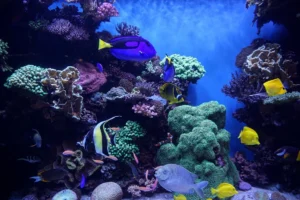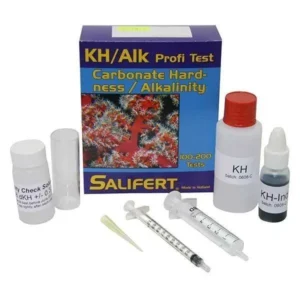Testing the various parameters in your saltwater tank is one of the most important of your ongoing maintenance tasks.
Saltwater fish and corals can be very sensitive to swings in some parameters resulting in unnecessary stress and even loss.
With a newer tank, the focus will be on testing ammonia, nitrite and nitrate as the tank goes through the Nitrogen Cycle.
As the tank matures that focus will include testing for phosphate, which is a major cause of algae, and elements used by corals as they grow, like calcium and carbonate.
Let’s look in more detail at what you should be testing for…

Table of Contents
What to Test For In a Saltwater Fish Tank
Fish Only Tank
In a fish-only tank, testing need not include those elements that are specific to coral growth, namely calcium, carbonate and magnesium.
These elements will not deplete in a fish-only tank and, even if they did, by a small amount, this would be replenished by regular water changes.
However, the following parameters do need testing on a regular basis:-
PH
The PH level of saltwater is between 7.6 and 8.4 and most saltwater aquarium keepers try to keep the level around 8.0 – 8.4, (with coral reef tanks towards the higher end).
Stability of the PH level is the most important thing though, rather than chasing a particular number.
PH will naturally rise during the day (when the lights are on) as algae and corals use up carbon dioxide during photosynthesis and will fall again at night as excess carbon dioxide forms carbonic acid which pushes the PH back down.
Having plenty of surface agitation, which will encourage gas exchange, is a good way to help stablise your PH level.
For more information read our article, How to Raise PH in a Saltwater Aquarium.
Salinity
The salinity of saltwater is usually measured in parts per thousand (ppt) or by its specific gravity. In general, the salinity of the ocean is around 35 ppt or 1.0264 specific gravity
Saltwater fish tanks are normally kept in the range of 1.024 – 1.026 (with coral reef tanks towards the higher end)
It’s possible that the salinity in your tank could creep up (or down) over time as you do daily top-ups for evaporation or periodic water changes so you need to test it regularly.
If your salinity does get too high, simply take some saltwater out and add fresh (RODI) water back in.
If your salinity gets too low, add saltwater instead of freshwater when topping up for evaporation loss.
Ammonia and Nitrite
Ammonia and nitrite are produced by fish waste and other decomposing matter and are removed by nitrifying bacteria, as part of the nitrogen cycle, producing nitrate.
However, in new tanks especially, there may be insufficient nitrifying bacteria available causing ammonia and nitrite to spike.
Even in established tanks, something could happen, like a fish death, that will cause a temporary spike in ammonia and nitrite so they should be tested for regularly.
Follow these links for more guidance on the nitrogen cycle, how to cycle your fisk tank and how you can combat ammonia and nitrite spikes using the bacteria supplements.
Nitrate
Nitrate, as the end product of the nitrogen cycle, is present in the ocean but in very small amounts.
In a saltwater fish-only tank, an acceptable level is probably around 10 – 40 ppm and can be reduced if the level gets too high by regular water changes.
High nitrate levels can also cause algae problems
In a Coral Reef Tank, however, a nitrate level of 10 would be at the higher end with 2-4 ppm being more acceptable. For an SPS coral dominant tank even lower at 0 – 2 ppm
Use of a skimmer will help reduce nitrates as will certain filter media designed for the purpose.
Phosphate
If you have an algae problem, then test for phosphates as a high level is likely to be the cause.
Nitrates and Phosphates should also be ‘in balance’, that is to say, in a certain ratio, generally regarded to be 100:1, so if your nitrate level is 10, your phosphate level should be 0.1.
If your nitrates are higher than this ratio, in relation to phosphates, you will likely have algae problems, if phosphates are higher you may get cyano.
Coral Reef Tank
For a coral reef tank, in addition to the tests above, you should also test for the following:-
Alkalinity, Calcium and Magnesium
The relationship between these chemical elements is complex (follow this link if you really want to know).
All we need to know, as saltwater fish tank keepers, is that corals consume calcium and carbonate to grow and that magnesium in the water keeps calcium and carbonate stable and in balance.
For a typically mixed coral reef tank you should aim for:-
- Alkalinity (KH) – 8 – 11 dkh
- Calcium – 400 – 450 ppm
- Magnesium – 1250 – 1350 ppm
Over time, and as corals grow, these levels will decrease and cannot be fully replenished by a percentage water change.
So, we need to add them back into the tank, by dosing the appropriate chemicals as needed.
Refer to our article, Reef Tank Dosing Guide for more information.
How to Test Your Saltwater Fish Tank

How to Test Your Saltwater Fish Tank? – Get a test kit (or kits)…
You are going to need to get test kits to test all the parameters outlined above.
There are many different types and makes available.
Some kits provide tests for more than one parameter, whilst, with others, it’s a single test per kit.
Check out our article, Best Test Kits for a Saltwater Fish Tank to find out more.
Test Your Saltwater Fish Tank FAQs
What should I test my saltwater fish tank for? – For new tanks, the focus will be on testing for Ammonia, Nitrite, and Nitrates as the tank initially cycles and good bacteria is established.
For established tanks, the focus shifts to testing for Nitrates and Phosphates as high levels of these can lead to algae problems.
If you keep LPS or SPS corals you will need to test levels of Calcium, Carbonate, and Magnesium as these are depleted as the corals grow.
How often should you test a saltwater aquarium? – Until your tank is well established you should test the levels of Ammonia, Nitrite, Nitrates, and Phosphates weekly. When Ammonia and Nitrite levels drop to zero you only need to test those if you think there is a major issue.
You should test the levels of Calcium and Carbonate every week and Magnesium fortnightly.
What is the best test kit for a saltwater aquarium? – In our opinion, the Salifert Marine Profi Test Kit Range are the easiest to use and most accurate.
You can learn more by viewing our article, Best Test Kits for a Saltwater Fish Tank.
How do I test the salt level in my aquarium? – You can use an in-tank hydrometer but these are notorious for giving inaccurate readings. For best results use a good-quality refractometer.
Saltwater fish tanks are normally kept in the range of 1.024 – 1.026 sg.
